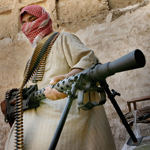While recent U.S. airstrikes that killed top commanders in Iraq and Afghanistan mean further losses for al-Qaida, the current political conditions in Iraq may favor its resurgence there. Those conditions include a deadlock in the outcome of the electoral process, a Shi’i-dominated alliance that many Sunni Arabs perceive as exclusionary, and increasing marginalization of the Sunni Arab Sahwa (Awakening) Councils.
In April 2010, Hamid al-Zawi (a.k.a. Abu Umar al-Baghdadi), the Emir of the Islamic State in Iraq (ISI), was killed in al-Tharthar desert area north of Baghdad, along with his Minister of War, Yusuf al-Dardiri (a.k.a. Abu Ayyub al-Masri otherwise known as Abd al-Mun‘im al-Badawi). An Egyptian who was previously a mid-ranking member of al-Jihad in Egypt, al-Masri had taken command of al-Qaida in Iraq (AQI) in June 2006. In October of that year, al-Baghdadi’s Shura Council of al-Mujahidin merged with AQI, along with more than ten other smaller groups, to form the ISI.
The formation of the ISI, however, marked the beginning of a downturn in al-Qaida’s influence in Iraq. The indiscriminately violent behaviour of the ISI/AQI, along with the expansion of its targets from coalition military forces to include less cooperative Sunni Arab tribesmen, Iraqi military and security bureaucracies, and virtually all non-Sunnis, led to the revolt of Sunni Arab tribesmen in early 2007. The Sahwa phenomenon began in Anbar province, targeting al-Qaida and disseminating anti-Iranian propaganda as opposed to anti-American. The lack of a charismatic leader after the June 2006 killing of Abu Musab al-Zarqawi and more serious efforts by Syria and Saudi Arabia to stop the flow of funds and volunteers also helped undermine al-Qaida. As no insurgency can survive without popular support, especially when the geography is not insurgent-friendly and the insurgency’s ideology is not attractive to the local community, there was a sharp decline in the operational capacity of AQI/ISI after 2007.
Despite its diminished capacity, the ISI was swift in replacing the top commanders killed in April 2010. Its new communiqué declared that “two are gone and three came.” Abu Bakr al-Baghdadi al-Qurashi became the new ISI Emir, Abu Abdullah al-Qurashi became his deputy, and al-Nasr Lidin Allah Abu Sulayman became the new Minister of War, replacing the late al-Masri. All of these aliases have historical and religious significance. Quraysh was the tribe of the Prophet Muhammad and linking the ISI’s new leaders directly to the Prophet makes them ashraf or ‘noblemen’ in Islamic culture. Al-Nasr Li Din Allah (Triumph for the Religion of God) was the title of Saladin, the famous Muslim commander who fought against European crusaders in the Levant in the 12th century. Thus AQI/ISI is trying to use symbolism to substitute for charismatic leadership.
As for the new commanders, there is little known about them. Abu Bakr was a commander of one of the small organizations that merged under the ISI; Abu Abdallah is a Moroccan who, like his predecessor al-Masri, has close contacts with al-Qaida central. As for al-Nasr, in his first statement he followed the rhetoric of al-Zarqawi by calling for escalation in attacks against Shi’i targets and Iraqi military and security forces.
Meanwhile, political developments in Iraq may be undercutting whatever gains the killings made against al-Qaida. Nuri al-Maliki, Iyad Allawi, and other leading politicians have warned against a return to political violence if they are denied power. The current compromise between the two leading Shi’i-dominated coalitions (the State of Law and the Iraqi National Alliance) might well exclude Allawi’s Iraqi National Movement (Iraqiyya) and its Sunni Arab backers from the forthcoming government. For their part, the Sahwa commanders have warned that security conditions could easily slip back to those of the notorious 2006-2007 period if they are not fully reintegrated into the Iraqi system or if their arms permits are withdrawn, a development that already occurred this month in Diayala, where some 9,800 Sahwa forces are stationed to fight AQI.
While the loss of Abu Umar and Abu Ayyub in Iraq (as well as Mustafa Abu al-Yazid in Pakistan) were significant blows against al-Qaida, the group’s lifeline in Iraq—as well as in Afghanistan and Yemen—is its tribal and organizational alliances. Those alliances ebb and flow depending on the local political environment. Between 2007 and 2010 several factors—the fact that Sunni Arab tribal areas became inhospitable, formation of the Sahwa Councils, and clashes with other armed groups such as the Islamic Army of Iraq and the 1920 Revolution Brigades—seriously undermined al-Qaida’s tribal alliances in Iraq. But this should not be taken for granted. An exclusionary, repressive political environment, in which politicians prefer violence to compromise, risks recreating insurgent-tribal alliances and contributing to an AQI recovery, despite repeated decapitation by drone strikes.
Omar Ashour is the Director of the Middle East Studies Program in the Institute of Arab and Islamic Studies, University of Exeter (UK). He is the author of The De-Radicalization of Jihadists: Transforming Armed Islamist Movements (London, New York: Routledge, 2009).






